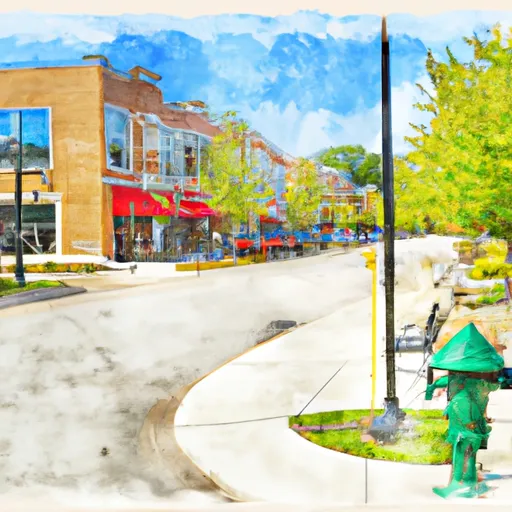-
 Snoflo Premium
Snoflo Premium
Get unlimited access to all our content
With no Ad interruptions! - Start Your Free Trial Login with existing account
Brighton
Eden Index
Climate
8.7
•
Recreation
6.1
•
Community
5.2
•
Safeguard
6.9/10

Brighton, Michigan is a charming city located in Livingston County. The climate in Brighton is typically warm and temperate, with an average annual temperature of 48.3°F. The city receives an average annual rainfall of 34.2 inches, and snowfall of 45.4 inches. The hydrology constituents of the area primarily consist of the Huron River and its tributaries. Visitors can enjoy kayaking, canoeing, fishing, and hiking along the Huron River. Brighton State Recreation Area offers over 4,000 acres of outdoor activities, including camping, fishing, and hunting. Other attractions in the area include Mt. Brighton Ski Resort, Kensington Metropark, and Island Lake State Recreation Area. Overall, Brighton, Michigan is a great destination for outdoor enthusiasts seeking adventure and natural beauty.
What is the Eden Index?
The Snoflo Eden Index serves as a comprehensive rating system for regions, evaluating their desirability through a holistic assessment of climate health, outdoor recreation opportunities, and natural disaster risk, acknowledging the profound impact of these factors on livability and well-being.
Climate Health Indicator (CHI): 8.7
Brighton receives approximately
801mm of rain per year,
with humidity levels near 77%
and air temperatures averaging around
9°C.
Brighton has a plant hardyness factor of
5, meaning
plants and agriculture in this region thrive during a short period during spring and early summer. Most
plants will die off during the colder winter months.
By considering the ideal temperature range, reliable water supplies, clean air, and stable seasonal rain or snowpacks, the Climate Health Indicator (CHI) underscores the significance of a healthy climate as the foundation for quality living.
A healthy climate is paramount for ensuring a high quality of life and livability in a region, fostering both physical well-being and environmental harmony. This can be characterized by ideal temperatures, reliable access to water supplies, clean air, and consistent seasonal rain or snowpacks.
Weather Forecast
Streamflow Conditions
St. Clair-Detroit
Area Rivers
St. Clair-Detroit
Snowpack Depths
St. Clair-Detroit
Reservoir Storage Capacity
St. Clair-Detroit
Groundwater Levels
Recreational Opportunity Index (ROI): 6.1
The Recreational Opportunity Index (ROI) recognizes the value of outdoor recreational options, such as parks, hiking trails, camping sites, and fishing spots, while acknowledging that climate plays a pivotal role in ensuring the comfort and consistency of these experiences.
Access to outdoor recreational opportunities, encompassing activities such as parks, hiking, camping, and fishing, is crucial for overall well-being, and the climate plays a pivotal role in enabling and enhancing these experiences, ensuring that individuals can engage in nature-based activities comfortably and consistently.
Camping Areas
| Campground | Campsites | Reservations | Toilets | Showers | Elevation |
|---|---|---|---|---|---|
| Appleton Lake - Brighton Rec Area | None | 888 ft | |||
| Camp Dearborn | 191 | 934 ft | |||
| Seven Lakes State Park | 75 | 959 ft | |||
| Mary Jane Thurston State Park | 35 | 644 ft | |||
| Groveland Oaks County Park | None | 963 ft | |||
| Arthur Latham Park | None | 736 ft | |||
| Bishop Lake - Brighton Rec Area | None | 901 ft | |||
| Murray Lake - Brighton Rec Area | None | 875 ft | |||
| Highland State Rec Area | 40 | 977 ft |
Nearby Ski Areas
Catastrophe Safeguard Index (CSI):
The Catastrophe Safeguard Index (CSI) recognizes that natural disaster risk, encompassing floods, fires, hurricanes, and tornadoes, can drastically affect safety and the overall appeal of an area.
The level of natural disaster risk in a region significantly affects safety and the overall livability, with climate change amplifying these risks by potentially increasing the frequency and intensity of events like floods, fires, hurricanes, and tornadoes, thereby posing substantial challenges to community resilience and well-being.
Community Resilience Indicator (CRI): 5.2
The Community Resilience Indicator (CRI) recognizes that education, healthcare, and socioeconomics are crucial to the well-being of a region. The CRI acknowledges the profound impact of these elements on residents' overall quality of life. By evaluating educational resources, healthcare accessibility, and economic inclusivity, the index captures the essential aspects that contribute to a thriving community, fostering resident satisfaction, equity, and social cohesion.

